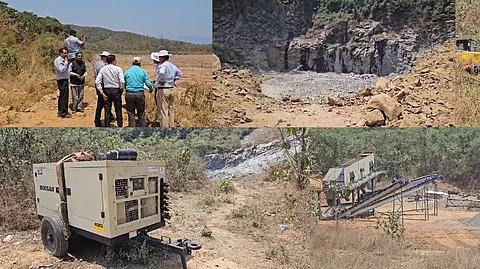

Illegal mining in the Tilari dam area has emerged as a grave threat to Goa's water security, raising serious concerns over the Goa government's passive stance.
Unchecked mining activities in Maharashtra are reducing the dam's water storage capacity, leading to the wastage of billions of litres of water.
Environmentalists have slammed this as not just an administrative failure but a betrayal that could jeopardize Goa's future water supply.
Local citizens and environmental activists have launched a chain hunger strike to protest the ongoing illegal mining. Wednesday (March 11) marked the seventh day of the protest. Despite repeated warnings from activists, the Goa government has been accused of ignoring the issue, allowing the situation to deteriorate further.
Environmental expert Dr. Rajendra Kerkar has consistently warned that continuous blasting in the Tilari dam area will severely reduce its water storage capacity, leading to a potential water shortage in Goa.
On Wednesday, environmental activist Ramesh Gavas, accompanied by officials from the Goa Water Resources Department, inspected the site and discovered five to six illegal mines in operation. The scale of the illegal activity left the officials stunned.
Gavas highlighted that the Goa government has invested ₹1,100 crore in the Tilari Dam project, while the Maharashtra government has contributed ₹400 crore.
The dam supplies water to three key talukas in North Goa . Pernem, Bicholim, and Bardez. Gavas warned that explosions caused by basalt mining could damage the dam’s structure, directly impacting the water supply to Bardez, a major tourism hub in Goa.
Repeated incidents of the Tilari canal bursting have already resulted in the loss of billions of litres of water, underscoring administrative failure and weak government policy.
A disruption in water supply could severely impact Goa’s tourism industry, with hotels, restaurants, and other businesses likely to face operational challenges. Environmentalists warn that such a scenario could lead to an economic downturn in the state.
Local activist Rajan Shetye pointed out that villagers from Shirange and Khanyale have already been relocated due to the threat of flooding. He cautioned that continued mining in flood-prone areas could have disastrous consequences.
The hunger strikers have demanded immediate intervention from the Goa government to pressure the Maharashtra government into halting the mining activities.
"The Goa government has invested heavily in the Tilari Dam, making it their responsibility to protect this critical resource," said the protesters.
Despite repeated warnings, the Goa government’s apparent indifference has sparked anger among locals. "Why is the government silent when Goa's water security is under threat from a neighboring state?" questioned the protesters.